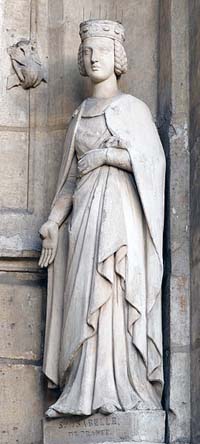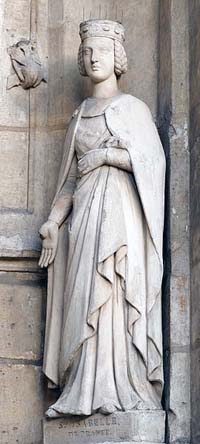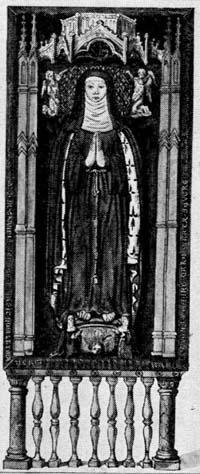The youngest daughter of Louis VIII of France and Blanche of Castile, younger sister of Louis IX of France and older sister of Charles I of Sicily. Founder of the Franciscan order Abbey of Longchamp.
Isabelle's father died when she was young, and her mother guided her studies where as Blanche became an expert in Latin. By the time she was a young lady, she was determined to remain a virgin, extremely religious and had refused prominent offers of marriage, receiving praise from Pope Innocent IV.
Isabelle founded the convent called the Order of the Poor Ladies near her home. The first stone of the convent church was laid on June 10, 1256, was completed when Pope Alexander IV gave his sanction on 2 February 1259. Isabelle refused the position of abbess, never joined the order, choosing instead to follow her beliefs from her own home near the convent.
Isabelle died in her house at Longchamp on 23 February 1270, and was buried in the convent church. After nine days her body was exhumed. As it showed no signs of decay, many miracles were said to have been witnessed at her grave. In 1521 Pope Leo X allowed the Abbey of Longchamp to celebrate her feast with a special office. On 4 June 1637, a second exhumation took place. On 25 January 1688, the nuns obtained permission to celebrate her feast with an octave, and in 1696 the celebration of the feast on 31 August was permitted to the whole Franciscan Order.
∼
When still a child at court Isabel was already devoted to religion. By the Bull of 26 May 1254, Pope Innocent IV allowed her to retain some Franciscan fathers as her special confessors. She was even more devoted to the Franciscan Order than her royal brother. She not only broke off her engagement with a count, but moreover refused the hand of Conrad IV of Germany, son of Frederick II, Holy Roman Emperor, although pressed to accept him by everyone, even by Innocent IV, who however did not hesitate subsequently to praise her fixed determination to remain a virgin. As Isabel wished to found a convent of the Order of Poor Ladies of Saint Clare, Louis IX began in 1255 to acquire the necessary land in the Forest of Rouvray, not far from the Seine west of Paris. On 10 June 1256, the first stone of the convent church was laid. The building appears to have been completed about the beginning of 1259, because Pope Alexander IV gave his sanction on 2 February 1259, to the new rule which Isabel composed along with a team of at least four leading Franciscans, including Saint Bonaventure. This rule was drawn up solely for this convent, which was named the Monastery of the Humility of the Blessed Virgin (monasterium humilitatis beatae Mariae virginis). In the rule the sisters were called the Sorores Ordinis humilium ancillarum Beatissimae Mariae Virginis ("sisters of the humble order of servants of the most blessed virgin Mary"). The fast was not so strict as in the Rule of Saint Clare; the community was allowed to hold property, and the sisters were subject to the Franciscans. Some of the first sisters came from the female Franciscan convent at Reims.
Isabel was not altogether satisfied with the first rule drawn up, and therefore submitted a revised rule to Pope Urban IV, through the agency of her brother Louis IX, who had also secured the confirmation of the first rule. Urban approved this new constitution on 27 July 1263. The difference between the two rules consisted for the most part in outward observances and minor alterations. This new rule was also adopted by other French and Italian convents of the Order of St. Clare, but one can by no means say that a distinct congregation was formed on the basis of Isabel's rule. In the new rule Urban IV gives the nuns of Longchamp the official title of sorores minores inclusae, which was doubtlessly intended to emphasize closer union with the Order of Friars Minor (the Franciscans).
The history of the Abbey of Longchamp had many vicissitudes. The French Revolution closed it, and in 1794 the empty and dilapidated building was offered for sale, but as no one wished to purchase it, it was destroyed. In 1857 the walls were pulled down except one tower, and the grounds were added to the Bois de Boulogne.
The youngest daughter of Louis VIII of France and Blanche of Castile, younger sister of Louis IX of France and older sister of Charles I of Sicily. Founder of the Franciscan order Abbey of Longchamp.
Isabelle's father died when she was young, and her mother guided her studies where as Blanche became an expert in Latin. By the time she was a young lady, she was determined to remain a virgin, extremely religious and had refused prominent offers of marriage, receiving praise from Pope Innocent IV.
Isabelle founded the convent called the Order of the Poor Ladies near her home. The first stone of the convent church was laid on June 10, 1256, was completed when Pope Alexander IV gave his sanction on 2 February 1259. Isabelle refused the position of abbess, never joined the order, choosing instead to follow her beliefs from her own home near the convent.
Isabelle died in her house at Longchamp on 23 February 1270, and was buried in the convent church. After nine days her body was exhumed. As it showed no signs of decay, many miracles were said to have been witnessed at her grave. In 1521 Pope Leo X allowed the Abbey of Longchamp to celebrate her feast with a special office. On 4 June 1637, a second exhumation took place. On 25 January 1688, the nuns obtained permission to celebrate her feast with an octave, and in 1696 the celebration of the feast on 31 August was permitted to the whole Franciscan Order.
∼
When still a child at court Isabel was already devoted to religion. By the Bull of 26 May 1254, Pope Innocent IV allowed her to retain some Franciscan fathers as her special confessors. She was even more devoted to the Franciscan Order than her royal brother. She not only broke off her engagement with a count, but moreover refused the hand of Conrad IV of Germany, son of Frederick II, Holy Roman Emperor, although pressed to accept him by everyone, even by Innocent IV, who however did not hesitate subsequently to praise her fixed determination to remain a virgin. As Isabel wished to found a convent of the Order of Poor Ladies of Saint Clare, Louis IX began in 1255 to acquire the necessary land in the Forest of Rouvray, not far from the Seine west of Paris. On 10 June 1256, the first stone of the convent church was laid. The building appears to have been completed about the beginning of 1259, because Pope Alexander IV gave his sanction on 2 February 1259, to the new rule which Isabel composed along with a team of at least four leading Franciscans, including Saint Bonaventure. This rule was drawn up solely for this convent, which was named the Monastery of the Humility of the Blessed Virgin (monasterium humilitatis beatae Mariae virginis). In the rule the sisters were called the Sorores Ordinis humilium ancillarum Beatissimae Mariae Virginis ("sisters of the humble order of servants of the most blessed virgin Mary"). The fast was not so strict as in the Rule of Saint Clare; the community was allowed to hold property, and the sisters were subject to the Franciscans. Some of the first sisters came from the female Franciscan convent at Reims.
Isabel was not altogether satisfied with the first rule drawn up, and therefore submitted a revised rule to Pope Urban IV, through the agency of her brother Louis IX, who had also secured the confirmation of the first rule. Urban approved this new constitution on 27 July 1263. The difference between the two rules consisted for the most part in outward observances and minor alterations. This new rule was also adopted by other French and Italian convents of the Order of St. Clare, but one can by no means say that a distinct congregation was formed on the basis of Isabel's rule. In the new rule Urban IV gives the nuns of Longchamp the official title of sorores minores inclusae, which was doubtlessly intended to emphasize closer union with the Order of Friars Minor (the Franciscans).
The history of the Abbey of Longchamp had many vicissitudes. The French Revolution closed it, and in 1794 the empty and dilapidated building was offered for sale, but as no one wished to purchase it, it was destroyed. In 1857 the walls were pulled down except one tower, and the grounds were added to the Bois de Boulogne.
Family Members
-
![]()
Philippe de France
1209–1218
-
Princess Valois Of France
1211–1270
-
![]()
Louis IX of France
1214–1270
-
![]()
Louis IX of France
1214–1270
-
![]()
Robert I d'Artois
1216–1250
-
![]()
Alphonse III de Poitiers
1220–1271
-
![]()
Philippe Dagobert de France
1222–1232
-
![]()
Charles of Anjou
1226–1285
-
![]()
Charles of Anjou
1226–1285
-
![]()
Charles I of Anjou
1226–1285
Advertisement
Explore more
Sponsored by Ancestry
Advertisement
















